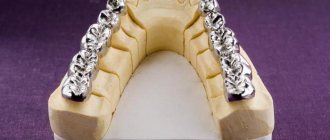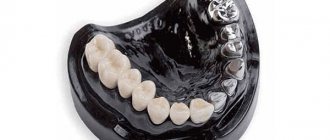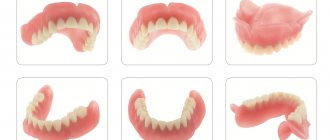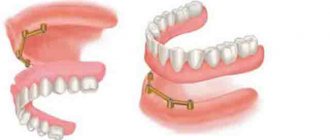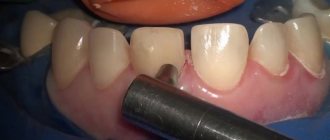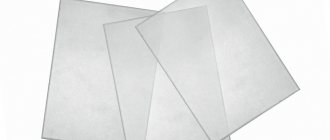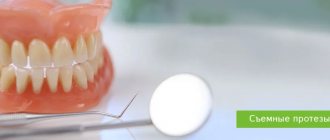Dental bridge: general characteristics
With the help of prosthetics, a number of visual and functional dental problems are solved. The name for the installation was not chosen by chance, because the principle of the device is reminiscent of engineering structures. Artificial crowns are held on a base, and adjacent intact incisors, canines and molars act as supporting elements.
The choice of the appropriate type of construction depends not only on the financial capabilities and personal preferences of the patient, but also on his medical history. That is why a full restoration is impossible without a thorough diagnosis, medical examination and adjustment of the finished system, created from casts, to the required parameters.
Types of Dental Bridges
Modern dental clinics offer many options for restoring lost units using prosthetic bridges. They differ according to different criteria:
- by manufacturing method - solid cast, adhesive, stamped, pressed, combined;
- by material - metal, metal-ceramic, ceramic, plastic, zirconium dioxide and aluminum oxide;
- according to the method of fastening - locking, adhesive, on healthy teeth, on implants.
There is also a classification according to purpose. For example, artificial prostheses are restorative, splinting, temporary and permanent.
Manufacturing technology
The main selection criterion is the amount of time spent on creating a design according to the individual standards of a particular patient. There are 3 main groups:
- Solid cast. Ideally adjacent to hard and soft tissues, airtight. In this way it is possible to reproduce the natural shape with high precision. They are strong and durable. The disadvantages include the need to grind healthy teeth, as well as the use of high-precision casting and the high cost of production.
- Adhesive. Modeling takes place directly in the oral cavity. This is a gentle alternative to the previous method when only one element is missing. There is no need to grind the adjacent crowns; the plates are glued to them using a special cement composition.
- Stamped. An outdated option that most doctors refuse because the product weighs a lot and often leads to injury to the supports.
Material for production
The type of raw materials from which products are made determines their durability, practicality and care. Modern clinics offer many options to suit every taste and budget. Types of bridges and their features (photos are presented in the article):
- Metal. They were actively used decades ago, cast from precious metals, gold and silver. They are distinguished by high strength and affordable price. However, this type has a significant drawback: the dentition looks unattractive. Damage to the supporting elements is also possible.
- Metal-ceramic. The base consists of an alloy, which is complemented by ceramic inserts. This option is considered ideal with an optimal ratio of cost and high quality. The color is matched to the shade of the enamel.
- Ceramic. There is no all-metal cast frame. These teeth look quite natural, but do not tolerate strong mechanical stress due to their fragility. You need to be very careful when wearing it.
- Plastic. They are used primarily as temporary substitutes for permanent products while they are being manufactured in the laboratory. They are produced very quickly, do not cause allergic reactions, weigh little, look attractive, but do not last long.
- Made from zirconium dioxide. All-ceramic combined dental bridges on this basis are among the most modern. They absorb all the advantages of their predecessors: light weight, reliability, aesthetic appeal, hypoallergenicity, long service life.
- Made from aluminum oxide. They are not widespread enough because they have an exorbitant price. In terms of durability, strength, beauty and other characteristics, they have proven themselves exclusively on the positive side.
Mounting type
The structures are attached in different ways, the most common in dentistry:
- Consolidation on healthy units. The product consists of crowns with holes intended for teeth and bridges that connect them. For strength, the elements are made solid. When choosing this type, preliminary grinding and depulping will be required. Dentists are resorting to the latter procedure less and less; modern technologies make it possible in some cases to skip this stage.
- On implants. When choosing this method, intact incisors, canines and molars remain intact. They will not be ground or depulped. However, the cost of treatment increases significantly.
- Adhesive method. The bridge is not put on supports, but is attached to the rear surface using special composite compounds.
- Lock fastening. This is a removable bridge, which, if necessary, can be detached and returned to its place. Grinding of the abutment crowns is also not carried out.
Metal-ceramic bridges –
Metal ceramics have a cast metal frame inside (Fig. 21), lined with porcelain on the outside. Unlike ceramics, metal is completely opaque, and therefore only opaque porcelain can be used to disguise it. The latter leads to the fact that metal-ceramic bridges and crowns will lack the translucency of natural tooth enamel, and their aesthetics will not be as good as that of metal-free ceramics.
The problem with aesthetics when using metal-ceramic prosthetics is somewhat reduced if you are going to prosthetize all the teeth that fall into the smile line at once (for example, at least from canine to canine). In this case, when talking, your interlocutors will see only the same “teeth”. But the problem with aesthetics is especially noticeable if a metal-ceramic bridge is installed on only 3-4 teeth, and in this case the crowns will stand out noticeably against the background of neighboring natural teeth.
Clinical case of metal-ceramic prosthetics –
The cost of 1 unit of metal ceramics varies on average from 12,000 to 18,000 rubles. Cheap metal ceramics costing from 8,000 to 10,000 rubles per unit also exist, but in this case the simplest ceramic mass (most likely of Belarusian or Russian production) will definitely be used, which simply lacks aesthetics. For 12,000 rubles per unit, you can already get bridges or crowns from Duceram ceramic mass (Germany), which at the very least provides a satisfactory level of aesthetics.
If more expensive ceramic masses are used, for example, it could be “Ivoclar” (Liechtenstein), then the cost of just 1 crown will increase to 15,000 rubles. The use of even higher quality ceramics “Noritake” (Japan) or “Vita” (Germany) will increase the cost to 18,000 rubles per unit, and therefore, if we are talking about a bridge of 3 units, then you need to multiply this amount by three. The amount of 18,000 rubles per 1 unit for good metal ceramics is not the maximum, and here’s why...
If we are talking about dental bridge prosthetics for the front teeth, then expensive ceramic mass alone is no longer enough to achieve good aesthetics. The fact is that with standard metal-ceramics, the lower edge of the metal frame (which is located just below the gum level) is not insulated with ceramics, and therefore it will always be in contact with the gum. Firstly, this leads to the gradual development of cyanosis of the gums, and secondly, to a gradual lowering of the gum level and exposure of the dark metal edge of the metal-ceramic crowns of the bridge (Fig. 24-25).
Therefore, if you are going to make a bridge on chewing teeth, all this may not be important, but in the area of the front teeth these problems will be critical. Only a type of metal-ceramic with the so-called “shoulder mass” can avoid the appearance of cyanosis, but the cost of 1 Unit of a bridge immediately increases by another 5,000 rubles (for the high complexity of manufacturing). So it turns out that for high-quality prosthetics with a bridge prosthesis for the front teeth, a bridge made of Emax metal-free ceramics can cost less than a good metal-ceramic one.
What does “metal-ceramic with shoulder mass” mean – as we said above – using a more expensive ceramic mass will not save you from the appearance of cyanosis and gum recession. For the latter, there are metal-ceramic bridges/crowns with the so-called “shoulder mass”, in which the lower edge of the metal frame is additionally insulated with ceramic mass. Ceramic insulation can be done either along the entire perimeter of the edge of the metal frame, or only on the front side of the crown (Fig. 27).
Conventional metal-ceramics and “with shoulder mass” –
As we said above, the cost of 1 unit of metal ceramics with shoulder mass will be an additional 5,000 rubles (for 1 unit). For a 3-unit bridge with shoulder mass, 2 crowns must be made, i.e. only those that will be on the supporting teeth. Accordingly, if we want a metal-ceramic bridge made of high-quality ceramics, then it will cost at least 45,000 rubles (and an additional + 10,000 rubles to this cost will also be used to create shoulder mass for crowns on abutment teeth). Total 55,000 rubles.
Important: it is worth considering that when calculating the cost of a dental bridge made of metal-ceramics, there are some other cost items. For example, the cost of temporary crowns made of plastic will be another 2,000 rubles per unit. Secondly, the cost of preparing supporting teeth for prosthetics, which can amount to another 2,500 to 8,000 rubles per tooth (depending on the number of root canals). As we see, to restore 1 missing front tooth it will be cheaper to install an economy-class implant, which even with a ceramic crown will cost you about 50,000 rubles.
Indications and contraindications for installation
The procedure is indicated when a person is missing one molar or 1-4 front incisors and canines. In this case, intact teeth should remain on the sides, which will subsequently act as supporting elements and withstand the greatest pressure when chewing food. Also, this cannot be avoided when the previous design has become unusable.
Despite all the advantages of orthopedic intervention, there is a list of cases when it is contraindicated:
- absence of more than 4 crowns;
- bruxism (involuntary grinding of the jaws, which is most often observed at night);
- malocclusion (before prosthetics you will have to undergo long-term orthodontic treatment);
- acute form of periodontitis or severe periodontal disease;
- pathological abrasion of the enamel layer;
- diseases of the skeletal system (for example, osteomyelitis);
- inflammatory processes in the oral cavity;
- poor hygiene preventing installation.
In addition, this also includes general contraindications to surgical intervention. These are problems with blood clotting, allergic reactions to drug components, manufacturing materials, chronic diseases during exacerbation, taking medications that prevent blood clots, and mental disorders.
Contraindications
Not all patients can get fixed dentures, because there are strong contraindications:
- pathologies of the temporomandibular joint;
- tooth mobility;
- chronic periodontal disease;
- pregnancy;
- severe bruxism;
- oncological diseases, blood diseases, mental disorders.
There are few absolute restrictions on installation. You can always choose the option of fixed prosthetics for each patient, taking into account his individual characteristics.
Advantages and disadvantages of dental bridges
Advantages of bridges in prosthetic dentistry:
- There is no need to wait for the installed structure to take root. That is, there is no need for osseointegration, which can last up to six months. It turns out that the adaptation process lasts quite quickly (up to 12 hours).
- This is the most economical option for restoring rows when individual units are lost than implantation.
- Modern technologies make it possible to obtain aesthetically attractive artificial teeth with full functioning. Hidden elements (fastenings, etc.) are not visible to others, so no one will even notice the medical intervention.
- The procedure has virtually no contraindications. A bridge is also placed in cases where implantation of an implant is not possible.
- Normal diction is maintained.
Weak sides:
- It is necessary to grind down the adjacent crowns remaining in the mouth. Very often, dentists resort to depulpation (removal of the nerve, cleaning and cementing of the canals).
- The normal load on the jaw bone is not fully restored. When a person chews food, the supports are loaded; the central part is practically not involved in this. As a result, the risk of bone tissue atrophy increases.
Results and discussion
In all modeling options, it is clear that the maximum stress occurs around the implant located closer to the cantilever element and on the surface of the abutment of this implant. The table shows the dependence of the maximum stresses on the surface of the bone on the load exerted on the structure with a cantilever element with a length of 4, 10, 12 mm.
Dependence of stresses in the bone tissue around implants on the magnitude of the load and the length of the cantilever element of a fixed prosthesis
The influence of the length of the console is as follows: the minimum stresses at a chewing pressure of 60 N in the presence of a console of 10 and 12 mm increase to 2.8 and 3.9 MPa, while with a console of 4 mm they do not exceed 1.6 MPa; the maximum stresses appear at a chewing pressure of 350 N and are 8.7 MPa with a console of 10 mm and 12.3 MPa - 12 mm, while with a console of 4 mm the stresses do not exceed 6 MPa. When the length of the cantilever element increases to 14 mm or more, stresses arise up to 20 MPa in the bone and up to 200 MPa in the implants, which indicates the possibility of their destruction.
When modeling the length of the cantilever part of the prosthesis of 10 mm, but with the application of different values of masticatory pressure (60N vertical and 24N horizontal; 350N vertical and 104N horizontal), stresses in the bone tissue were obtained in excess of 23 MPa, even with sufficient sizes of supporting implants (diameter 3.5 mm and length 9 mm for the one located closer to the cantilever element; diameter 5 mm and length 14 mm for the one located further from the cantilever element). At such stresses, destruction of bone tissue is possible, since, according to the literature, peak loads during the chewing process can exceed the loads applied to the models in this study, and the strength limits of cortical bone are 45 MPa (cancellous bone 15 MPa), with a safety margin within 50 %. Thus, for this orthopedic design, implants with a diameter of 4.5-5 mm and a console length of no more than 12 mm are recommended.
According to a number of authors, it has been established that studies carried out by the finite element method allow one to draw conclusions about the general patterns of load distribution, but cannot calculate the clinical individual structure, therefore it should be borne in mind that accurate data on the parameters of the stress-strain state of bone tissue are purely individual for each patient [17].
Installation of a dental bridge: stages of the procedure
The process of manufacturing and installing the structure is simple and does not require additional actions aimed at violating the integrity of soft tissues, suturing, etc. The adaptation period is easy and painless. Despite its simplicity, the doctor and patient will have to go through several successive steps before the lost units are completely restored. On average, 3 visits to the dental office will be required.
Stage 0: sanitation of the oral cavity before the procedure
If during the initial examination the specialist suggested installing a bridge, he should carefully examine the oral cavity. One of the main conditions for prescribing treatment is the absence of carious lesions, inflammatory processes and other dental disorders.
The duration of this period depends on the condition of hard and soft tissues. If a person regularly visits the clinic for preventive purposes, it is likely that a routine cleaning will be required without applying filling material. If there are advanced diseases, they must be treated, and only then can you contact an orthopedist.
Stage 1: preparation of abutment teeth and production of a bridge.
When the dentist is sure that all units are completely healthy, a support is selected. The elements are ground, depulped, and the roots are filled.
Impressions are taken from the finished fastenings. They are sent to the dental laboratory.
While the permanent product is being manufactured, the patient will have to wear a temporary one with a plastic base. This may take 1-2 weeks depending on the workload of the institution and the complexity of the technological processes.
When there are not enough natural teeth, or they are of too poor quality, they cannot be cured and properly prepared for the procedure, implantation is indicated. Typically two anchor points are implanted.
Stage 2: installation of a fixed prosthesis
At the last visit to the dental clinic, the plastic structure is dismantled, and in its place is installed one made in the laboratory using impressions. The orthopedist checks how tightly the material adheres to the surfaces. There should be no obstruction to the closure of the jaws and no visible color differences, otherwise the artificial areas will be noticeable.
A full fitting, fitting and fixation is carried out. For greater reliability, special cement is applied.
If the client feels discomfort, prosthetics are not performed. The system is dismantled and returned to the laboratory for adjustment. If there are no unpleasant sensations, the treatment is completed.
Adaptation occurs even while wearing plastic. This means that the patient will be able to easily return to their normal lifestyle within a few hours. The doctor gives recommendations on the use and care of the product, prescribes routine examinations and provides other important information.
conclusions
— with an increase in the length of the cantilever element in a fixed prosthesis on implants by a factor of 2, the stresses in the bone increase almost linearly, and with a decrease in the diameter of the implants — according to a quadratic law;
— in cases of replacing a defect on the antagonizing side with a complete removable denture, partial removable lamellar denture, or clasp denture, it is possible to manufacture a cantilever element in a fixed structure up to 12 mm supported on implants with a diameter of 4 mm and a length of more than 10 mm;
— if there is an intact dentition on the opposite jaw or a fixed orthopedic structure supported by dental implants, it is not recommended to model a cantilever element with a length of more than 8 mm supported by implants with a diameter of less than 4.5 mm and a length of less than 10 mm;
— since the main stress when recreating chewing loads occurs around the implant located closer to the cantilever element of the fixed structure, it is recommended not to reproduce tight occlusal contact between the masticatory surface of the cantilever element and the antagonists.
Recommendations after installation
Artificial structures also need to be properly maintained. If hygiene rules are not followed, this will significantly reduce the life of the product, and the patient will again have to use the services of an orthopedist.
Dentists recommend the following measures when performing dental prosthetics with bridges:
- Daily cleaning in the morning and evening. You must use a brush and paste. After each meal, you need to rinse your mouth with clean water or mouthwash, and use floss (dental floss).
- Hard-to-reach areas and interdental spaces are cleaned using sweeping movements without pressing on the crowns.
- It is important to exclude hard nuts, seeds and other foods from your diet that can cause chips and cracks.
- During the first time after installation, you should not drink coffee and tea, red wine, or freshly squeezed juice.
- You should visit the dental clinic for preventive examinations at least once every six months and undergo professional cleaning.
All structures have a certain service life. It depends on the material used and manufacturing technique. This period varies from 5 to 15 years. Sooner or later the product will have to be replaced, otherwise it may simply break and fall out.
The device is dismantled prematurely with the following problems:
- loosening;
- broken crowns;
- chipping of small fragments, appearance of microcracks;
- inflammation of soft tissues, bleeding gums;
- washing out the cement composition on which the system rests.
Only a specialist can safely remove the prosthesis; you cannot do it yourself at home. If you follow all the rules listed above, your smile will remain dazzling for a long time, and replacement will not be needed soon.
How does adaptation proceed after fixed prosthetics?
Adaptation to fixed species occurs individually. After installation, you may experience the following inconveniences:
- excessive salivation;
- gagging;
- discomfort during chewing;
- speech distortion;
- loss of taste.
The sensations last for several days. Many people complain of pain, scratches and abrasions. Pain when chewing at first may be normal. You need to limit solid foods. If you are salivating, you need to drink more, if you have a gag reflex, breathe through your nose, rinse your mouth with saline solution.
When to see a doctor
You should consult a doctor if there is severe pain, structural mobility, swelling in the area of the pins, or increased temperature. Timely assistance will help quickly resolve the problem. Independent actions lead to damage or breakage of the structure and rejection of the implant.
How much does it cost to build a bridge?
The price for dental bridge crowns is determined by the cost category of the impressions, the design itself, installation and fitting services. There are the cheapest options available to most patients, but they will be significantly inferior to the more expensive ones in terms of operational and other characteristics.
On average, a budget bridge can be installed for 3 thousand rubles. Zirconium and metal-ceramic elements will cost 20 thousand or more, especially if implantation was performed.
The main factors on which the final installation cost depends
What affects the cost of orthopedic intervention:
- Material of manufacture. Plastic can be purchased several times cheaper than metal or ceramics. The last option with a zirconium dioxide frame is the most expensive.
- Application of implants. They can significantly increase the number of zeros on a check.
- Number of elements to install.
- Clinic location. Treatment in Moscow is much more expensive than in the regions.
- Pricing policy of a dental institution. This is due to market conditions, competitiveness, status and reputation of dentists.
Prosthetics allows you to restore lost teeth in a short time and without large material costs. When installing the structure, certain conditions must be met, and the patient must go through several successive stages. Unfortunately, despite the obvious advantages, bridges are not without their negative aspects. In addition, there are contraindications when it is not possible to restore the aesthetic appeal of a smile without harm to health in this way.
General overview
The standard model of a bridge is made with the expectation of installation on parallel straight elements of the dentition. However, the presence of defects expressed in the form of deviations requires the search for alternative solutions. One of the options is partial removal of enamel from the supporting tooth, however, such a procedure most often becomes the cause of new pathological processes.
A composite bridge prosthesis allows you to cope with this task. Its design provides for the presence of an articulation, with the help of which the system is successfully fixed on units with different initial structures. The manufacturing material is medical steel, which is safe for the patient’s body from the point of potential allergy development.
The configuration of the composite “bridge” includes the following elements:
- An intermediate occlusal pad placed over the edentulous area;
- Clamps that secure the structure to supporting elements;
- A prosthetic mechanism that connects the system into a solid structure.
Hook-clasps, ring fastenings, inlays, and telescopic crowns can be used as fasteners.
Care
Daily care of a cantilever prosthesis involves carefully cleaning the surface of the artificial enamel from plaque. Hygiene is carried out with a regular toothbrush and toothpaste without abrasive particles. After this, be sure to go through the thread to remove stuck food particles that cause rotting and an unpleasant odor.
After the procedure, the oral cavity should be rinsed with a disinfectant solution that contains herbal decoctions and natural oils. A good assistant for caring for any dentures is an irrigator. The compact device, using a miniature nozzle, washes away any deposits at the base of the gums, helps prevent the formation of stone, and protects against pathogenic bacteria.
Design features
The connecting element that combines the components of the bridge is the main difference characteristic of the structures under consideration. The models used to restore the dentition differ based on the type of articulation:
- Systems the connection of which requires the presence of a groove and a protrusion;
- Models equipped with pin locks;
- Prostheses for which clasps are used;
- Designs equipped with additional crowns.
Regardless of the design features, the functional task of the prosthesis remains the same - replacing the edentulous area by installing an artificial crown.
Advantages and disadvantages
The positive aspects noted when using composite bridges form the following list:
- Effective restoration of the physiological functions of the jaw;
- Correction of aesthetic defects, as well as articulation problems;
- The minimum period of adaptation to the prosthesis is 7-10 days;
- Ease of use and strength of structure fixation;
- Affordable cost – traditional implantation is much more expensive.
Among the disadvantages characteristic of the prosthetic technique under consideration, it is worth noting:
- A prerequisite is the presence of support units;
- Incorrect distribution of chewing pressure on the jaw row;
- The need to prepare the enamel of the elements that serve as the base.
Despite the growing popularity of the use of implants, composite bridges remain a popular option that allows you to quickly and inexpensively eliminate dental defects.

